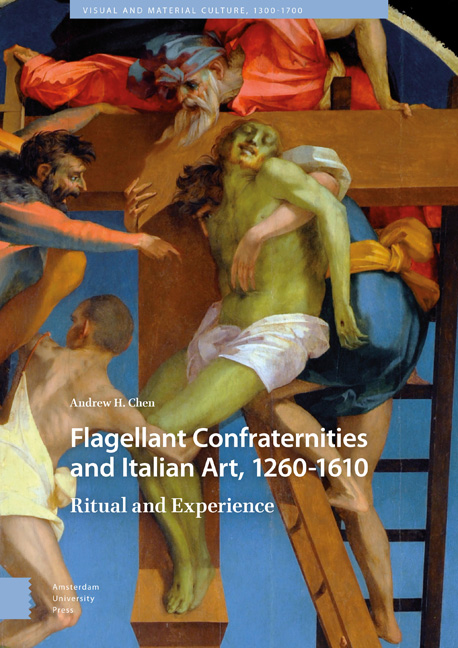Book contents
- Frontmatter
- Deduction
- Contents
- Abbreviations
- List of Illustrations
- Acknowledgements
- Introduction
- Part I Art and Ritual, to 1450
- 1 Flagellation and Its Settings
- 2 Images at Entrances, and Ascesis
- 3 Mass
- 4 Comforting
- 5 Processions
- Part II Transformations
- 6 Changes in Ritual Before Trent
- 7 Changes in imagery before Trent: Sansepolcro and Volterra
- 8 After Trent: Florence and Milan
- Epilogue: Global Flagellation
- Bibliography
- Index of Illuminated Manuscripts (by location)
- Index of Paintings (by location)
- Index of Topics
2 - Images at Entrances, and Ascesis
Published online by Cambridge University Press: 11 December 2020
- Frontmatter
- Deduction
- Contents
- Abbreviations
- List of Illustrations
- Acknowledgements
- Introduction
- Part I Art and Ritual, to 1450
- 1 Flagellation and Its Settings
- 2 Images at Entrances, and Ascesis
- 3 Mass
- 4 Comforting
- 5 Processions
- Part II Transformations
- 6 Changes in Ritual Before Trent
- 7 Changes in imagery before Trent: Sansepolcro and Volterra
- 8 After Trent: Florence and Milan
- Epilogue: Global Flagellation
- Bibliography
- Index of Illuminated Manuscripts (by location)
- Index of Paintings (by location)
- Index of Topics
Summary
Flagellant confraternities were made up of people of different professions who, when they came together for their rituals, temporarily assumed a corporate identity. They were not real hermits; but they did symbolically abscond from the world, on a ritual basis. This chapter seeks to describe how images in entrance spaces enhanced these acts of withdrawal. Presented here are three examples of mural decoration, from Clusone, Leonessa, and Siena, which confraternity members faced when they entered their oratories, and which shaped their attitudes and frames of mind – primed them for the rituals to come.
The impressive facade of the Oratorio dei Disciplini in Clusone, northeast of Bergamo, shows the Triumph of Death, Dance of Death, and Mouth of Hell (Figs. 25–26). The iconography of this monument is often discussed in terms of its relationship to other examples of macabre imagery in Italy and elsewhere. The meaning of the Clusone frescoes is inflected by the inclusion of flagellant donor imagery. Flagellants make a double appearance in the painted facade. A group of confratelli wearing hoods and habits marked with the confraternity's red cross are shown in a fragment at the lower right (Fig. 26a). A fragment of a framing element which separated them from the macabre scenes is still visible. One brother at the head of the bunch, possibly Raniero Fasani, is distinguished by a halo and his unmasked face. He turns his head back toward his companions while lifting his arms away from them. The others kneel behind him. Whatever was to the right of the group is now unintelligible.
On the other side of the facade is Hell. The three naked women suffering in the Mouth of Hell are labelled Pride (Superbia), Avarice (Avaritia), and Wrath (Ira). The flagellants are linked, by contradistinction, with virtue and Paradise.
In the register above, a hooded flagellant is among the people who dance the equalizing, all-embracing dance with death (Fig. 26b). The living include a worker with ripped stockings, a sad-looking garzone carrying a wooden pitcher, a pilgrim, a merchant, a lovesick man, and a man of learning, either a doctor or a lawyer.
A well-dressed woman looking into a mirror emerges from a building to the left populated with other women; a skeleton clutches her right arm, and another touches her hand lightly.
- Type
- Chapter
- Information
- Flagellant Confraternities and Italian Art, 1260–1610Ritual and Experience, pp. 84 - 103Publisher: Amsterdam University PressPrint publication year: 2018



